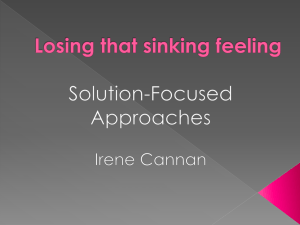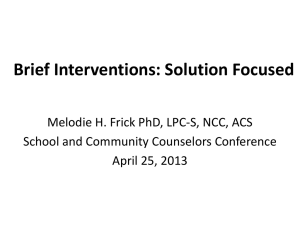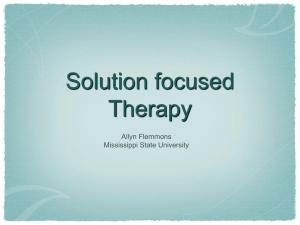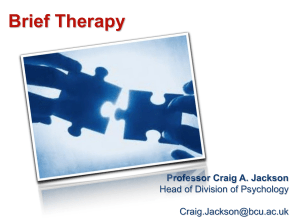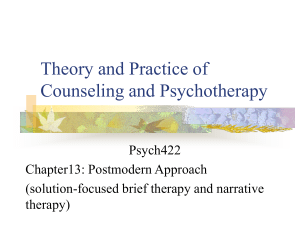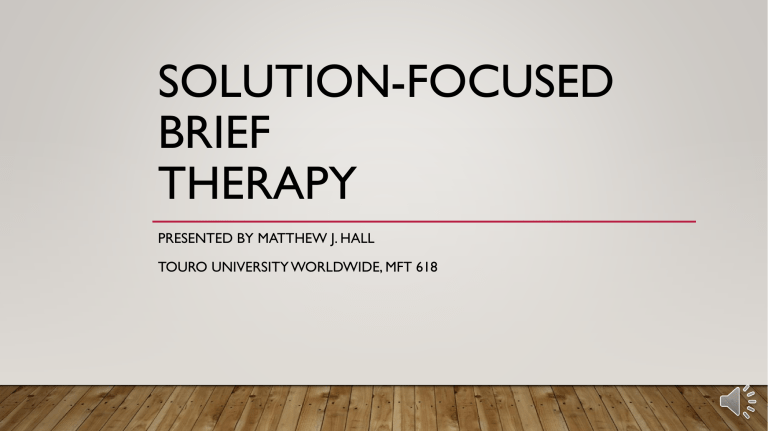
SOLUTION-FOCUSED BRIEF THERAPY PRESENTED BY MATTHEW J. HALL TOURO UNIVERSITY WORLDWIDE, MFT 618 SFBT (Solution Focused Brief Therapy) Symptoms or issues that brought the individual to therapy are typically not discussed WHAT IS IT? Goal oriented therapy Focus on the present and the future Much as in it’s name, the point is finding solutions to problems Therapists encourage development as they determine abilities, resources and skills needed to achieve the client’s vision of the future. HISTORY OF SFBT *IMAGE CREDIT TO SOLUTIONFOCUSED.NET *PICTURED TO THE RIGHT: STEVE DE SHAZER & INSOO KIM BERG • Developed in the early 1980’s by Steve de Shazer and Insoo Kim Berg of the Brief Family Therapy Center in Milwaukee • Developed as a response to inefficiency of change in the therapeutic process • Utilized by therapists in Asia, Europe, Canada, South America, and the United States SO . . . HOW DOES IT WORK? • Practitioners help clients visualize change and execute toward those goals • The therapist is a guide and coach for exploration of finding solutions to current problems • Emphasis on learning from current toolsets • SFBT recognizes that most people know change is needed and likely already have the necessary skills to create that change • The client is the expert and the therapist is the coach who outlines problems and goals SOLUTION FOCUSED BRIEF THERAPY ------------------------------------TECHNIQUES SFBT in practice uses specific types of questions to help the therapist facilitate exploration of client skillsets Recognizing what can be learned from past experiences gives client’s another toolset to use and returns feelings of independence COPING QUESTIONS Coping questions demonstrate to those in treatment their resilience in coping with challenges and how they have done so previously. Ex: “Considering how severe your anxiety has been lately, how have you been fulfilling your daily obligations to work and family?” Recognition of skills MIRACLE QUESTIONS • “If not for _____, how would your life look?” • Creates an opportunity to see what can be changed Present questions in the form of “on a scale of 0 to 10” as an assessment of progress or circumstances. SCALING QUESTIONS A quick way of determining attributes like hopefulness, motivation, and confidence. Used when there is not enough time to explore miracle questions ISSUES EFFECTIVELY TREATED USING SFBT • Positive results in both individual and group therapy • Individuals from all backgrounds, cultures, and ages have found beneficial results • Research has shown it to be a useful intervention for school behavioral and academic concerns, substance abuse, family therapy, and couples counseling PURSUING TRAINING IN SFBT Certifications are issued by the International Alliance of Solution-Focused Teaching Institutes (IASTI) Three levels of certification: Level 1: Solution-focused practitioner Level 2: Advanced solution-focused practitioner Level 3: Master solution-focused practitioner REFERENCES • Team, G. T. E. (n.d.). Solution-Focused Brief Therapy (SFBT). Retrieved from https://www.goodtherapy.org/learn-about-therapy/types/solution-focused-therapy. • Why would a therapist choose to use SFBT? • What led to the development of SFBT? REVIEW • Can you see yourself using this therapeutic model in your practice? • What are three basic ideas behind SFBT? • What types of questioning are used in SFBT?
